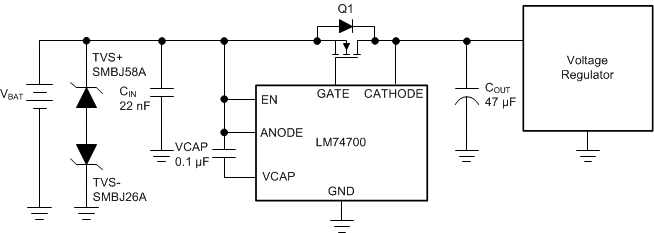ZHCSHV4G October 2017 – December 2020 LM74700-Q1
PRODMIX
- 1 特性
- 2 应用
- 3 说明
- 4 Revision History
- 5 Pin Configuration and Functions
- 6 Specifications
- 7 Typical Characteristics
- 8 Parameter Measurement Information
- 9 Detailed Description
-
10Application and Implementation
- 10.1 Application Information
- 10.2 OR-ing Application Configuration
- 11Power Supply Recommendations
- 12Layout
- 13Device and Documentation Support
- 14Mechanical, Packaging, and Orderable Information
10.1.1.4 Selection of TVS Diodes and MOSFET for 24-V Battery Protection Applications
Typical 24-V battery protection application circuit shown in Figure 10-3 uses two uni-directional TVS diodes to protect from positive and negative transient voltages.
 Figure 10-3 Typical 24-V Battery Protection with Two
Uni-Directional TVS
Figure 10-3 Typical 24-V Battery Protection with Two
Uni-Directional TVSThe breakdown voltage of the TVS+ should be higher than 48-V jump start voltage, less than the absolute maximum ratings of anode and enable pin of LM74700-Q1 (65 V) and should withstand 65-V suppressed load dump. The breakdown voltage of TVS- should be lower than maximum reverse battery voltage –32 V, so that the TVS- is not damaged due to long time exposure to reverse connected battery.
During ISO 7637-2 pulse 1, the input voltage goes up to –600 V with a generator impedance of 50 Ω. This translates to 12 A flowing through the TVS-. The clamping voltage of the TVS- cannot be same as that of 12-V battery protection circuit. Because during the ISO 7637-2 pulse, the Anode to Cathode voltage seen is equal to (-TVS Clamping voltage + Output capacitor voltage). For a 24-V battery application, the maximum battery voltage is 32 V, then the clamping voltage of the TVS- should not exceed, 75 V – 32 V = 43 V.
Single bi-directional TVS cannot be used for 24-V battery protection because breakdown voltage for TVS+ ≥ 65 V, maximum clamping voltage is ≤ 43 V and the clamping voltage cannot be less than the breakdown voltage. Two un-directional TVS connected back-back needs to be used at the input. For positive side TVS+, SMBJ58A with the breakdown voltage of 64.4 V (minimum), 67.8 (typical) is recommended. For the negative side TVS-, SMBJ26A with breakdown voltage close to 32 V (to withstand maximum reverse battery voltage –32 V) and maximum clamping voltage of 42.1 V is recommended.
For 24-V battery protection, a 75-V rated MOSFET is recommended to be used along with SMBJ26A and SMBJ58A connected back-back at the input.